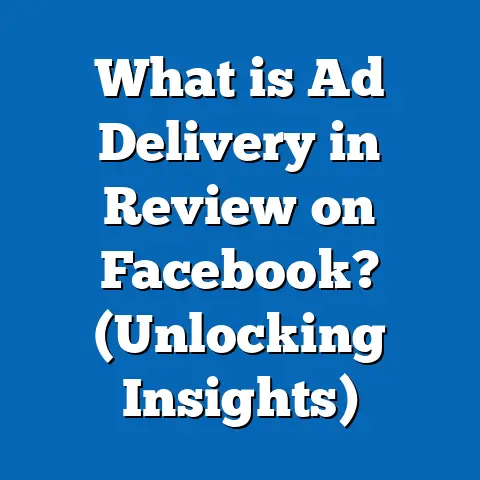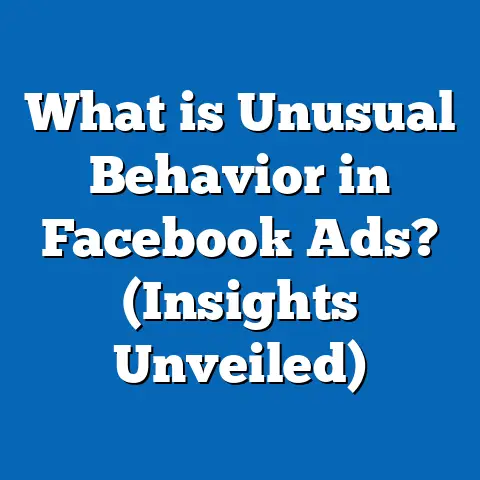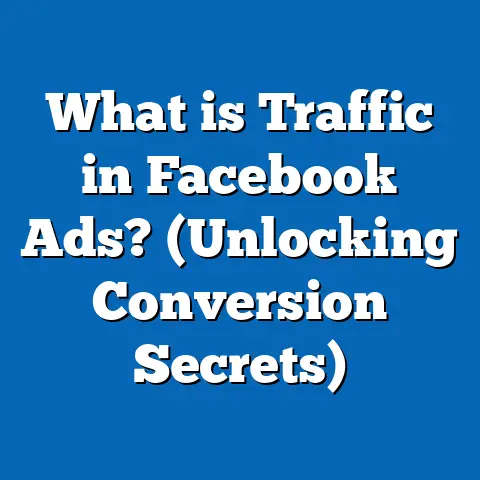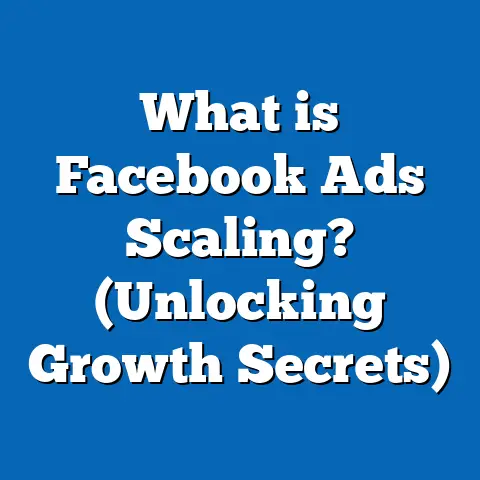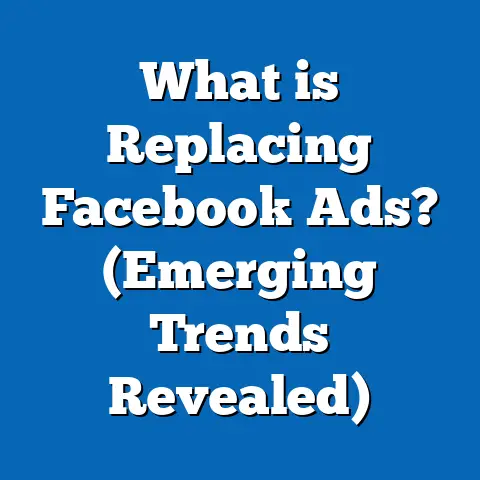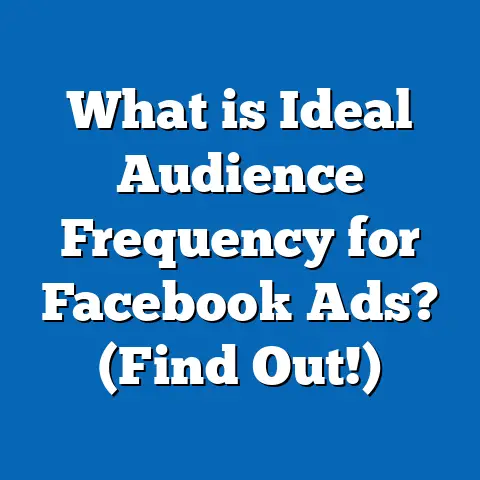What is an Ad Set? (Unlocking Facebook Ads Strategy)
What is an Ad Set? (Unlocking Facebook Ads Strategy)
Introduction: The Curious Case of Facebook Ad Sets
Ever noticed how Facebook ads seem to follow you around like an invisible shadow? One minute you’re scrolling through your feed, and the next, an ad for that pair of shoes you glanced at online appears as if by magic. Behind this almost spooky precision lies one of Facebook’s most powerful tools for advertisers: the Ad Set.
Facebook ads are not just random posts; they’re carefully orchestrated campaigns where every element has a purpose. The Ad Set is where much of the magic happens — it controls who sees your ads, how much you spend, where your ads appear, and when they show up. Understanding this is key to running successful Facebook ads that deliver real business results.
In this guide, we’ll break down everything you need to know about Ad Sets—from basic definitions and core components to advanced strategies and real-world case studies. We’ll provide data-backed insights, practical examples, and actionable tips to help you master Facebook advertising.
Facebook Ads Structure: Campaign > Ad Set > Ad
To unlock the power of Ad Sets, start by understanding the hierarchy within Facebook advertising:
- Campaign: This is the overarching structure where you set your marketing objective. Whether it’s brand awareness, lead generation, or conversions, your campaign defines what you want to achieve.
- Ad Set: The middle layer where you decide who will see your ads, how much you spend on them, when they appear, and where they show up. The targeting and budget decisions happen here.
- Ad: The creative itself—images, videos, headlines, text—that users interact with.
The Ad Set acts as the control room for your audience and budget. Multiple ads can exist within a single Ad Set, each testing different creative approaches but targeting the same audience with the same budget.
What is an Ad Set?
An Ad Set is a grouping tool within Facebook Ads Manager that lets you specify:
- Audience targeting (who sees your ads)
- Budget (how much you’re willing to spend)
- Ad schedule (when your ads run)
- Placements (where your ads appear)
- Bidding strategy (how Facebook optimizes delivery to meet your goals)
All ads inside one Ad Set share these settings. For example, if you create three different ads targeting women aged 25-34 interested in fitness, all those ads would be part of the same Ad Set.
Why Are Ad Sets Important?
Precise Audience Targeting
Facebook boasts over 2.9 billion monthly active users worldwide (Statista, 2024), but not every user is your ideal customer. Ad Sets allow advertisers to slice and dice this vast audience into meaningful segments by demographics, interests, and behaviors.
This precision reduces wasted impressions on uninterested users and increases the likelihood of conversions.
Efficient Budget Management
Budgets are set at the Ad Set level. This means you can allocate different amounts of money to different audience groups under one campaign. For instance:
- $100/day targeting new customers
- $50/day retargeting website visitors
This gives you granular control over how your ad spend is distributed.
Testing and Optimization
Running multiple Ad Sets targeting different audiences or using different bidding strategies allows you to compare performance side-by-side. You can then shift budgets toward high-performing sets to maximize ROI.
Deep Dive Into Ad Set Components
Audience Targeting in Ad Sets
Targeting is arguably the most crucial aspect of any Facebook ad campaign. With 98% of marketers utilizing Facebook for precise audience targeting (HubSpot, 2023), mastering this can transform your campaigns.
Facebook’s targeting options fall into three main categories:
Core Audiences
These are built using Facebook’s vast data on user demographics and activity:
- Age
- Gender
- Location
- Language
- Interests (e.g., hiking, gaming)
- Behaviors (e.g., frequent travelers)
Example: A travel company might create an Ad Set targeting males aged 25–45 interested in adventure travel.
Custom Audiences
Custom Audiences let you use your own data to target users:
- Customer email lists
- Website visitors via Facebook Pixel
- App users
- Engagement audiences (people who interacted with your Facebook/Instagram page or videos)
This is a powerful way to retarget warm leads or existing customers.
Lookalike Audiences
Lookalikes find new users similar to your best customers based on data signals. For example, if you have a list of high-value customers, Facebook can create a Lookalike Audience representing people who share similar traits.
Budgeting and Scheduling
You set budgets at the Ad Set level in two ways:
- Daily Budget: Amount spent each day.
- Lifetime Budget: Total amount spent over the entire campaign duration.
Facebook also allows you to schedule when your ads run—important for businesses with specific peak hours or seasonal events.
Data from Facebook shows that advertisers using lifetime budgets combined with scheduled delivery see up to a 20% improvement in cost-efficiency over daily budgets without scheduling.
Placements: Where Your Ads Appear
Facebook Ads can appear in multiple places across its ecosystem:
- Facebook Feed
- Instagram Feed
- Stories (both platforms)
- Audience Network (third-party apps/sites)
- Messenger Inbox
Advertisers can choose Automatic Placements, letting Facebook decide where ads perform best, or manually select placements based on their strategy.
According to a 2023 survey by Social Media Examiner:
- 72% of advertisers saw better results opting for automatic placements initially.
- Manual placement optimization often yields better ROI once sufficient data is collected.
Bidding Strategies
Bidding determines how Facebook spends your budget to get the most value:
- Lowest Cost: Default option aiming for cheapest conversions.
- Cost Cap: Keeps costs within a certain limit.
- Bid Cap: Caps maximum bid per impression/action.
- Target Cost: Aims for consistent cost per conversion.
Choosing the right bidding strategy can reduce your Cost Per Acquisition (CPA) by up to 25%, as seen in multiple industry case studies.
How Ad Sets Impact Campaign Performance: Data Insights and Case Studies
Data Insight: Audience Size vs Performance
A WordStream study from 2023 analyzed 10,000 Facebook campaigns and found:
| Audience Size | Average CTR | CPA |
|---|---|---|
| <100k | 1.5% | $35 |
| 100k – 500k | 2.2% | $28 |
| 500k – 1 million | 2.8% | $22 |
| >1 million | 2.5% | $25 |
Larger audiences generally allow Facebook’s algorithm more room to optimize but require more substantial budgets for effective data gathering.
Case Study: E-commerce Brand Scaling with Multiple Ad Sets
A mid-sized fashion retailer aimed to scale their online sales using Facebook Ads. Initially, they ran broad campaigns with a single Ad Set targeting women aged 18–45. Results were mediocre: ROAS hovered around 1.5x.
They restructured their campaigns into multiple focused Ad Sets:
- Ad Set 1: Women aged 18–24 interested in fast fashion
- Ad Set 2: Women aged 25–34 interested in sustainable clothing
- Ad Set 3: Retargeting past website visitors
Budget was allocated dynamically based on performance metrics monitored daily. Within two months:
- ROAS increased by 35%
- CPA dropped by 22%
- Conversion rate improved by 18%
This success was attributed to isolating audiences in separate Ad Sets rather than lumping them together—allowing tailored creatives and budget allocation per group.
Advanced Strategies for Using Facebook Ad Sets
Split Testing (A/B Testing) at the Ad Set Level
Split testing helps identify what works best by comparing multiple variables while keeping others constant.
What You Can Test at the Ad Set Level:
- Different audience segments (e.g., interest vs behavior-based)
- Geographic locations
- Bid strategies (lowest cost vs cost cap)
- Lookalike audience sizes (1% vs 5%)
Example: A SaaS company might test two Ad Sets—one targeting “Marketing Managers” and another targeting “Small Business Owners”—to see which performs better for lead generation.
Dynamic Creative Optimization Within Ad Sets
Dynamic creative allows advertisers to upload multiple headlines, images/videos, descriptions, and calls-to-action at once. Facebook then automatically tests various combinations within an Ad Set and serves the best-performing creatives more often.
This can increase CTR by up to 30% compared to manually testing single creatives (Facebook internal data).
Scaling Campaigns: Manual Budgets vs Campaign Budget Optimization (CBO)
Facebook offers two ways to manage budgets across multiple Ad Sets:
Manual Budgets
Set budgets individually at each Ad Set level. This gives precise control but requires constant monitoring and manual adjustments.
Campaign Budget Optimization (CBO)
Set one budget at campaign level; Facebook automatically distributes funds among ad sets based on performance signals in real-time.
Performance Comparison:
| Metric | Manual Budget | CBO |
|---|---|---|
| CPA | Slightly higher | Lower by ~15% |
| Management Time | High | Lower |
| Flexibility | High | Moderate |
CBO works best for advertisers who trust Facebook’s AI optimization and want less hands-on management.
Comparing Facebook’s Ad Set Model With Other Platforms
| Feature | Facebook Ad Sets | Google Ads Ad Groups | LinkedIn Campaign Groups |
|---|---|---|---|
| Hierarchy | Campaign > Ad Set > Ads | Campaign > Ad Group > Ads | Campaign Group > Campaign > Ads |
| Targeting | Detailed demographic & interest-based | Keyword + demographic | Professional demographics + interest |
| Budget Control | Per Ad Set or Campaign | Per Campaign or Per Ad Group | Per Campaign Group |
| Placement Control | Multiple platforms inside Facebook | Search + Display networks | LinkedIn feed + partner sites |
| AI Optimization | Available via CBO | Available via Smart Bidding | Limited |
Facebook’s layered approach offers granular control unmatched in many other platforms but comes with increased complexity requiring expertise for optimization.
Practical Tips for Creating Effective Facebook Ad Sets
- Start Small and Scale Gradually
Begin with broad audiences before narrowing down based on data insights. - Segment Audiences Thoughtfully
Don’t lump diverse groups together; create distinct ad sets for meaningful segments like age groups or interests. - Leverage Custom Audiences for Retargeting
Use website visitors or customer lists to re-engage warm leads effectively. - Experiment with Bidding Strategies
Try lowest cost first but test cost caps or bid caps when needed. - Use Automatic Placements Initially
Let Facebook find optimal placements before optimizing manually based on performance data. - Monitor Frequency Closely
High frequency causes ad fatigue; aim for showing ads no more than 2–3 times per user per week. - Analyze Key Metrics Regularly
Focus on metrics like CPA, CTR, ROAS, and adjust budgets accordingly. - Avoid Audience Overlap
Use Facebook’s Audience Overlap tool to prevent ad sets from competing against each other internally.
Common Mistakes to Avoid With Facebook Ad Sets
- Running too many ad sets with insufficient budget leading to poor data quality.
- Not segmenting audiences properly causing inefficient spend.
- Ignoring placement optimization and bidding strategies.
- Failing to pause or update underperforming ad sets.
- Overlapping audiences causing internal competition and inflated costs.
- Neglecting mobile optimization since over 94% of Facebook users access via mobile devices (Statista, 2024).
- Underestimating the importance of creative relevance per target audience.
- Setting unrealistic expectations without proper testing phases.
Future Trends in Facebook Advertising & Impact on Ad Sets
Facebook continuously evolves its advertising platform with AI enhancements and privacy shifts affecting targeting capabilities:
- Increasing use of AI-driven budget allocation will make CBO more efficient.
- Privacy changes like Apple’s iOS updates limit tracking; expect more reliance on first-party data through Custom Audiences.
- Integration of augmented reality (AR) ads could require new ad set segmentation strategies focusing on immersive experiences.
- Growth in video content consumption calls for dynamic creative strategies within ad sets emphasizing video assets.
- Expansion into metaverse platforms may introduce new placement options within ad sets in coming years.
Staying informed about these trends will help advertisers adapt their ad set strategies proactively.
Summary: Key Takeaways About Facebook Ad Sets
- An Ad Set defines who sees your ads, when they appear, where they show up, how much you spend, and how bids are managed.
- Proper use of ad sets enables precise audience segmentation and optimized budget allocation.
- Testing multiple ad sets helps identify winning audiences and bidding strategies.
- Use data-driven insights to continuously refine targeting, placements, budgets, and creatives.
- Avoid common pitfalls like audience overlap and underfunded ad sets.
- Stay updated on platform changes and emerging trends to keep campaigns effective.
Next Steps: How to Master Your Facebook Ad Sets Today
- Audit your current campaigns; break broad ad sets into well-defined segments.
- Create custom audiences for retargeting and lookalikes for prospecting.
- Use split testing tools regularly at the ad set level.
- Monitor key metrics daily; adjust budgets based on performance trends.
- Experiment with placement settings—start automatic, then refine manually.
- Learn about new features like CBO and dynamic creative optimization.
- Keep pace with evolving privacy regulations and platform updates to maintain compliance and effectiveness.
Mastering the art of the Facebook Ad Set unlocks powerful control over your advertising success!

